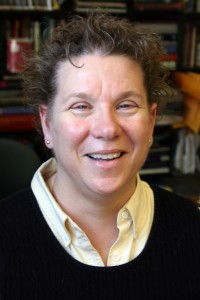
Imagine traveling to Siberia. In the winter. For science.
Been there, done that, for Gayle Woloschak. She traveled to Ozersk, a Russian village whose borders require security clearance to breach, to advise scientists on how to handle samples.
These were not ordinary samples. They dated back to the Cold War era and came from animals that had been systematically irradiated by Soviet scientists to understand the effects of radiation on the body.
Gayle was brought to Ozersk because she is a radiation biology expert and creator of the Northwestern University Raditation Archive (NURA), a collection of animal tissue samples from U.S. government-sponsored radiation experiments. Her mission in establishing the archive was to advance the understanding of radiobiology in a cost-effective manner and with reduced animal sacrifice.
In addition to advising colleagues around the globe, Gayle advises graduate students and maintains a radiation biology and bionanotechnology research lab as a Professor of Radiation Oncology at Northwestern. She also teaches radiation biology to medical residents, co-directs the residency training program and the Cancer and Physical Sciences Program at the Robert H. Lurie Comprehensive Cancer Center, and is the Vice President of the Radiation Research Society.
Gayle received her B.S. in Biology from Youngstown State and credits her undergraduate professor, Dr. Lauren Schroeder, for her decision to go into research. “He was an ecologist and I had the chance to work in his lab for about 2 years running experiments. In the end, I loved it, and he encouraged me to continue,” says Gayle. She went on to earn her Ph.D. in Immunology from the Medical College of Ohio and completed post-doctoral training in Immunology/Molecular Biology at Mayo Clinic. She worked in the Bioscience Division at Argonne National Laboratory for 15 years before her unusual transition to a position at Northwestern, “Northwestern needed someone to teach radiation biology to the residents, so I did this while still at Argonne. Eventually it evolved into a full-time faculty position,” says Gayle.
Gayle remains involved in research at Argonne as the Associate Director for Microbeam Science. She helped developed the Bionanoprobe (BNP), the only X-ray microscope in the world that can image cryogenically preserved biological samples with 30 nm resolution. The BNP is used primarily by the Woloschak Laboratory to study the localization of nanoparticle therapeutics in cancer cells and tissue. The tomographic capabilities of the BNP also allow for 3D reconstruction of the cells. “The idea, when we came up with it over 12 years ago, was to design a way look at samples in their native states,” says Gayle.
Outside of the lab, Gayle has a Doctor of Ministry degree and is active in the science-religion dialogue in Chicago and nationwide. She finds the dialogue “stimulating but also necessary to keep religious groups from having fears about science issues like evolution.”
Any way you look at it, Gayle is a teacher. When asked what she would be doing if she were not in her current position, Gayle says, “I’d be trying to do the same thing at another university. I love science and I love sharing it with others.”
AWIS Chicago
Association for Women In Science: Chicago Area Chapter
